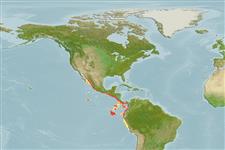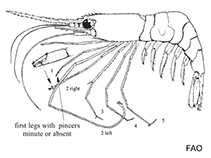Heterocarpus vicarius Fazon, 1893
Northern nylon shrimp| Native range | All suitable habitat | Point map | Year 2050 |

|
| This map was computer-generated and has not yet been reviewed. |
| Heterocarpus vicarius AquaMaps Data sources: GBIF OBIS |
Google image | No image available for this species;
drawing shows typical species in Pandalidae.
Classification / Names Common names | Synonyms | CoL | ITIS | WoRMS
Malacostraca | Decapoda | Pandalidae
Environment: milieu / climate zone / depth range / distribution range Ecology
Benthic; depth range 73 - 1454 m (Ref. 101379). Tropical, preferred 23°C (Ref. 107945); 28°N - 17°S, 112°W - 72°W
Distribution Countries | FAO areas | Ecosystems | Occurrences | Introductions
Eastern Pacific: southeast Gulf of California, Mexico to Mollendo, Peru.
Distribution in Guatemala possibly true based on native range although no reference for Guatemala has been found yet.
Length at first maturity / Size / Weight / Age
Maturity: Lm 11.7 range ? - ? cm Max length : 11.0 cm TL male/unsexed; (Ref. 8)
Life cycle and mating behavior Maturity | Reproduction | Spawning | Eggs | Fecundity | Larvae
Main reference
References | Coordinator | Collaborators
Holthuis, L.B. 1980 FAO Species Catalogue. Vol. 1. Shrimps and prawns of the world. An annotated catalogue of species of interest to fisheries. FAO Fish. Synop. 125(1):271 p. Rome: FAO. (Ref. 8)
IUCN Red List Status
(Ref. 130435: Version 2025-1)
CITES status (Ref. 108899)
CMS (Ref. 116361)
Threat to humans
Human uses
Fisheries: commercial
| FishSource | Sea Around Us
Tools
More information
Diet composition
Food consumption
Predators
Max. ages / sizes
Length-weight rel.
Length-length rel.
Length-frequencies
Mass conversion
Abundance
Internet sources
BHL | BOLD Systems | CISTI | DiscoverLife | FAO(Publication : search) | Fishipedia | GenBank (genome, nucleotide) | GloBI | Gomexsi | Google Books | Google Scholar | Google | PubMed | Tree of Life | Wikipedia (Go, Search) | Zoological Record



